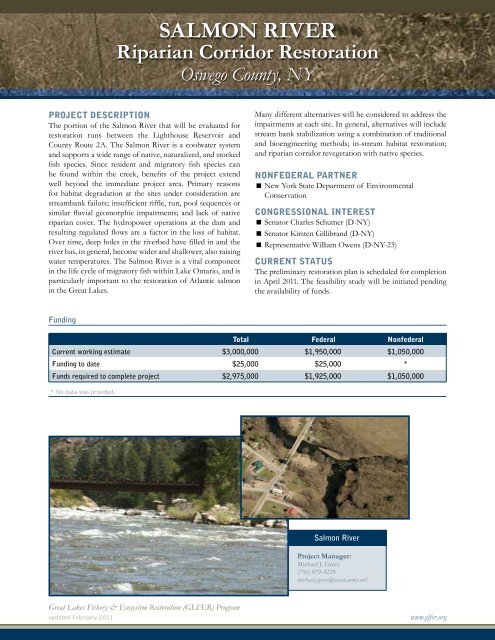Great Lakes Fishery and Ecosystem Restoration Program Project ...
Great Lakes Fishery and Ecosystem Restoration Program Project ...
Great Lakes Fishery and Ecosystem Restoration Program Project ...
Create successful ePaper yourself
Turn your PDF publications into a flip-book with our unique Google optimized e-Paper software.
SALMOn RIVER<br />
Riparian Corridor <strong>Restoration</strong><br />
Oswego County, NY<br />
ProjECt DESCriPtion<br />
The portion of the Salmon River that will be evaluated for<br />
restoration runs between the Lighthouse Reservoir <strong>and</strong><br />
County Route 2A. The Salmon River is a coolwater system<br />
<strong>and</strong> supports a wide range of native, naturalized, <strong>and</strong> stocked<br />
fish species. Since resident <strong>and</strong> migratory fish species can<br />
be found within the creek, benefits of the project extend<br />
well beyond the immediate project area. Primary reasons<br />
for habitat degradation at the sites under consideration are<br />
streambank failure; insufficient riffle, run, pool sequences or<br />
similar fluvial geomorphic impairments; <strong>and</strong> lack of native<br />
riparian cover. The hydropower operations at the dam <strong>and</strong><br />
resulting regulated flows are a factor in the loss of habitat.<br />
Over time, deep holes in the riverbed have filled in <strong>and</strong> the<br />
river has, in general, become wider <strong>and</strong> shallower, also raising<br />
water temperatures. The Salmon River is a vital component<br />
in the life cycle of migratory fish within Lake Ontario, <strong>and</strong> is<br />
particularly important to the restoration of Atlantic salmon<br />
in the <strong>Great</strong> <strong>Lakes</strong>.<br />
Funding<br />
Many different alternatives will be considered to address the<br />
impairments at each site. In general, alternatives will include<br />
stream bank stabilization using a combination of traditional<br />
<strong>and</strong> bioengineering methods; in-stream habitat restoration;<br />
<strong>and</strong> riparian corridor revegetation with native species.<br />
nonfEDErAl PArtnEr<br />
New York State Department of Environmental<br />
Conservation<br />
CongrESSionAl intErESt<br />
Senator Charles Schumer (D-NY)<br />
Senator Kirsten Gillibr<strong>and</strong> (D-NY)<br />
Representative William Owens (D-NY-23)<br />
CUrrEnt StAtUS<br />
The preliminary restoration plan is scheduled for completion<br />
in April 2011. The feasibility study will be initiated pending<br />
the availability of funds.<br />
Total Federal Nonfederal<br />
current working estimate $3,000,000 $1,950,000 $1,050,000<br />
funding to date $25,000 $25,000 *<br />
funds required to complete project $2,975,000 $1,925,000 $1,050,000<br />
* No data was provided.<br />
salmon river<br />
<strong>Project</strong> Manager:<br />
Michael J. Greer<br />
(716) 879-4229<br />
michael.j.greer@usace.army.mil<br />
<strong>Great</strong> <strong>Lakes</strong> <strong>Fishery</strong> & <strong>Ecosystem</strong> <strong>Restoration</strong> (GLFER) <strong>Program</strong><br />
updated February 2011 www.glfer.org


